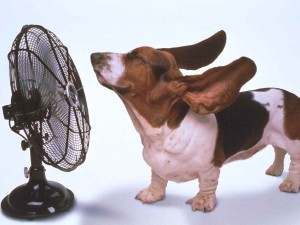 Caring pet owners already know how dangerous it is to leave their dogs in the car. However, leaving pets outdoors or in hot, unventilated, indoor places on hot summer days can also be extremely dangerous. What people forget is their dogs cannot handle the heat the same as we can. Dogs do not have sweat glands like humans, except for a few on their feet. They do not perspire and can only rid their bodies of heat by panting, which is not enough when temperatures soar.
Caring pet owners already know how dangerous it is to leave their dogs in the car. However, leaving pets outdoors or in hot, unventilated, indoor places on hot summer days can also be extremely dangerous. What people forget is their dogs cannot handle the heat the same as we can. Dogs do not have sweat glands like humans, except for a few on their feet. They do not perspire and can only rid their bodies of heat by panting, which is not enough when temperatures soar.
This is especially true with brachycephalic (dogs with short, flattened noses), such as Boxers, Bulldogs, Boston Terriers, Lhasa Apsos, Shih Tzus, Pekinese, etc. and their fur coats retain heat, making warm temperatures even more uncomfortable. This can cause them to suffer more quickly from heat stress. Dogs with heavy coats, heart or respiratory troubles, those who are exercising too much in the heat, as well as overweight, very young, infant and elderly dogs all need special consideration in the heat and have a greater likelihood of developing heat stroke. Heat stroke occurs when normal body mechanisms cannot keep the body’s temperature in a safe range.
Heat Stroke symptoms include:
- A rapid or erratic heartbeat/pulse
- Rapid breathing, or struggling for breath
- Exaggerated panting, or the sudden stopping of panting
- Increased, excessive, loud, heaving, irregular panting or the sudden stopping of panting
- A very high body temperature – usually, cell damage begins to occur at body temperatures over 106 degrees
- Excessive drooling, or frothing at the mouth
- Dark red gums
- Vomiting
- Barking or whining
- Anxiety or agitation
- Dizziness
- Confusion
- Incoordination – stumbling and/or trouble standing or walking
- An anxious, vacant, or staring expression
- Listlessness or weakness
- Shaking or seizures
- Collapse or unconsciousness
Other signs of heat stroke can include some or all of the following:
- Dry mouth and nose
- Lack of urine production
- Weakness and muscle tremors
- Dryness and redness (or dull grayish-pink or blue) of the inside of the tongue, mouth, lips and gums and gums – OR – drooling and excess salivation
- Glazed eyes and/or dilated pupils
- Difficulty standing or walking
- Vomiting and/or diarrhea
Animals showing these signs need immediate medical treatment, so take the dog to a vet as soon as possible. Click here for further information on what to do